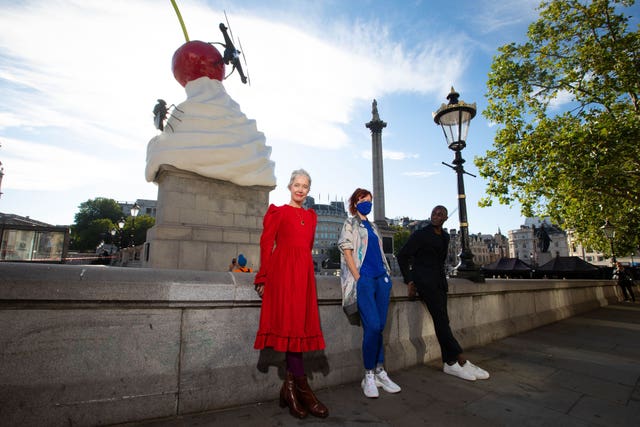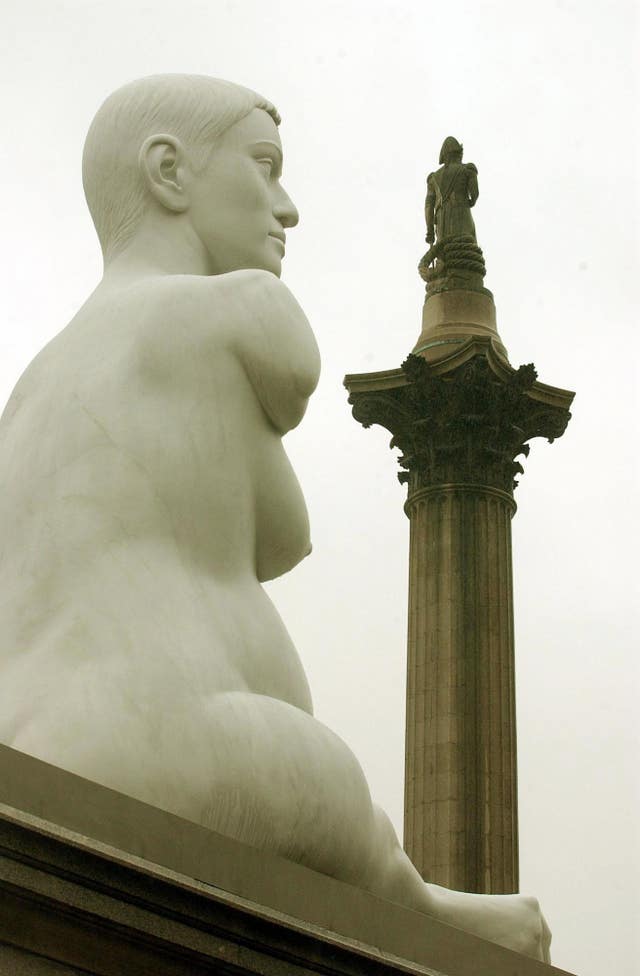Fourth Plinth whipped cream and fly sculpture unveiled
The installation in London’s Trafalgar Square was postponed by four months because of coronavirus.

A sculpture depicting a whirl of cream topped with parasites has been unveiled in London’s Trafalgar Square.
The installation on the Fourth Plinth – home to a rolling commission of public artworks – was postponed by four months because of the impact of coronavirus.
But the “dystopian” artwork – topped with a cherry, a drone and a fly – has now been unveiled.
Passers-by will be able to use their mobile phones to live-stream what the camera-equipped drone can see or people can log in to a website remotely.
Described as representing “exuberance and unease” and a “monument to hubris and impending collapse”, The End, by British artist Heather Phillipson, will stay in place until spring 2022.
The 13th Fourth Plinth commission is the tallest so far – at nearly 31ft (9.4m).
It replaces artist Michael Rakowitz’s recreation of a protective deity destroyed by Islamic State in Iraq.
Ekow Eshun, chairman of the Fourth Plinth commissioning group, described the new work as “audacious and beguiling”.
“It expresses something of the fraught times that we’re currently living through while also standing in conversation with the artistic and social history of Trafalgar Square,” he said.
“I’m sure this this will be a hugely popular commission that will inspire everyone who sees it physically and experiences it digitally.”


The Fourth Plinth commissions have seen many memorable works over the years, including Marc Quinn’s sculpture of pregnant Alison Lapper, and Yinka Shonibare’s scaled-down replica of HMS Victory, contained in a glass bottle.
Antony Gormley created One & Other, in which people – including a man who posed naked – took it in turns to spend an hour on the plinth.
Justine Simons, London’s deputy mayor for culture and creative industries, said: “The Fourth Plinth is the world’s most famous public art prize and each new sculpture breathes fresh life into our public realm.
“When Heather’s work was selected two years ago, we could never have imagined the world we find ourselves in today, but we always knew this sugary swirl with a dystopian flavour would spark a conversation.”
The artist said she felt “mixed emotions” about the unveiling.
“Obviously it’s a strange time to be doing anything right now… But it also felt like it was never going to be the right time so maybe it was the right time to just let it happen,” Ms Phillipson said.

“For me, we’ve been at a point of some kind of implosion for a long time. When I was thinking of this work there was a sense… of an undercurrent that was already there.
“I came up with the idea in 2016 which was already, for me, quite a tricky political moment”, she said, because of the “Brexit (vote) and the rumblings of Trump’s imminent election” in the US.
“This feels like a continuation of that … the idea of something being on the verge of collapse. The pandemic … attunes them to a slightly higher frequency.”
Ms Phillipson added the sculpture was not necessarily meant to be “pessimistic” but was also “hopeful” and signalled a “chance of radical change”.
But she said: “We are still in a state of collapse.”





